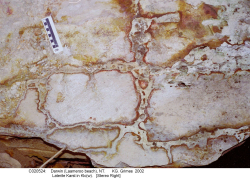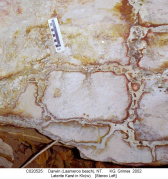
The main area is the early Palaeozoic limestones of the Daly, Wiso and Barkly karst regions. Limestone crops out around the edge of these basins, but much of it is buried beneath Mesozoic and Cainozoic sediments.
Outside that area the small black dots are isolated areas of Precambrian dolomite karsts.
Purple dots are areas of laterite karst (mainly shallow pans) - there is probably much more of this, but it is poorly documented.
File: NT-karst.png

